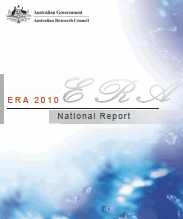
Peter Doherty
Second Guessing Peer Review Though the ERA - of What Value - at What Cost

Elizabeth Blackburn
|
Editorial
- 01 February 2011 |
|
|
|
|
|
Second Guessing Peer Review Though the ERA - of What Value - at What Cost |
 Elizabeth Blackburn |
In
February 2008 the new federal
Minister for Innovation, Industry, Science and Research, Senator Kim Carr,
announced that he would replace the Coalition’s proposed Research Quality
Framework (RQF), which in turn was modelled on Britain’s Research Assessment
Exercise (RAE, instituted in 1986) with a new quality assurance oversight of
research in Australia’s universities which came to be known as Excellence in
Research for Australia (ERA) with its first
national report released on January 31, 2011.
For all three of these exercises the
rationale was/is based on the assumption that the implementation of
retrospective evaluation of university research will lead to more cost-effective
support.
It is undeniable that following
the introduction of the RAE, the quality of Britain’s university research
improved significantly. The argument is, however, one of
post hoc ergo propter hoc, but concurrent with the funding allocations
derived from the RAE was a marked and continued increase in the allocation of
resources to foster university research. To date no proponent of retrospective
evaluation has made any attempt to analyse their relative importance.
On the other hand as far back as
March 2004 Australia’s oldest living Nobel Laureate, Peter Doherty, noted for
The Australian’s Dorothy Illing a
fundamental difference from the US system. There, a $1 million grant for five
years would attract a 42% payment ˗ or $420,000 ˗ to the host institution for
infrastructure support. True, Australia’s Labor government has moved to increase
defraying oncosts, but it has a long way to go before meeting them.
Then in June 2005 the ABC’s Ticky
Fullerton interviewed Professor Doherty in preparation for the
Four Corners’ “The Degree Factories”:
[T]he problem comes with the way that research
support funds outside the competitive system are allocated. [T]he Australia
Research Council and the National Health and Medical Research Council,
distribute their resources on the basis of …peer review, …it’s equivalent to the
process in the United States used by [the] National Institutes of Health, or in
Britain, used by [the] Medical Research Council or [the US] National Science
Foundation and so forth… you don’t really need a Research Assessment Exercise in
this country. All you have to do is to look at where the research grant money
goes. Now the Americans haven’t had a research assessment exercise, and the
reason they haven’t had is that they simply pay indirect costs on the grants. As
far as I’m concerned you don’t allocate research resources to an institution.
You allocate them to individuals. Research is about the activities of individual
human beings and the groups that they build in competing for the best outcomes,
okay. So you don’t fund universities to do research; you fund people to do
research and you then incidentally fund the institutions that support those
people, and the way you do that is through an indirect cost rate mechanism.
Agreed that the system of peer
review is imperfect, but introducing bureaucratic hindsight, which by its very
nature is prejudiced against promising new researchers, is patently counterproductive. What is urgently required is updating the peer review systems
of the ARC and the NHMRC, and allocating an increasing proportion of funding
through competitive grants with adequate oncosts.
counterproductive. What is urgently required is updating the peer review systems
of the ARC and the NHMRC, and allocating an increasing proportion of funding
through competitive grants with adequate oncosts.
A crucial improvement of peer
review would be to engage a significant proportion of overseas reviewers but
without the inconvenience and expense of long-distance travel. As an example,
William Sims Bainbridge, a sociologist and program director at the U.S. National
Science Foundation (NSF) is developing the use of Second Life where the avatars
of a group of peer reviewers for the NSF examine the question: “Can the hard
work of grant review be done without face-to-face meetings?”
According to Dr Bainbridge: “the
format of the meetings followed a traditional schedule, and all of the work was
completed on time”. Were only a fraction of the $35.8 millon that Senator Carr
so far admits to investing in his ERA to be directed toward improving the system
of peer review and rebalancing the proportion of funding between block grants
and competitive grants with adequate oncosts, a significantly greater return on
research investment would be realised.
And the admonishment by
Australia’s most recent Nobel Laureate, Elizabeth Blackburn, rebutted:
“I think there are tremendously
good scientists in Australia but sometimes [I wonder] are they really being able
to run with it in the way they are capable of?”
In the US, she said she benefited from a five-year grant that allowed
her to follow her nose without having to write up “damn little” reports and
catalogue milestones on a regular basis. “This was the perfect setting and I'm
not aware that I would have been able to do that [here]. Short dribs and drabs”
of money with tight constraints on basic research are in her opinion wasteful.
Alex Reisner
The Funneled Web